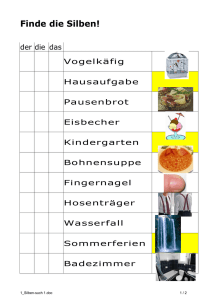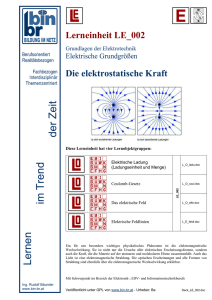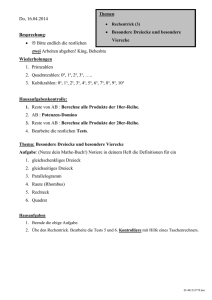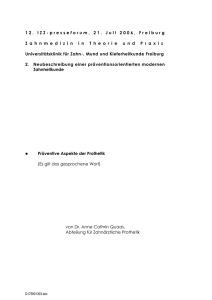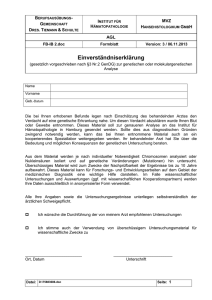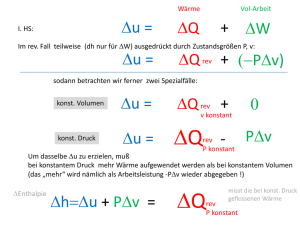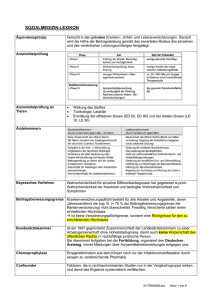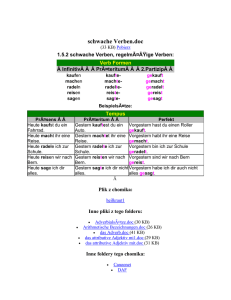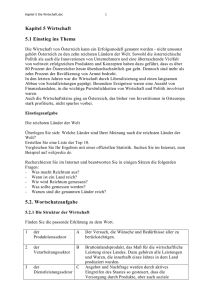Eine Einführung in Apache CouchDB
Werbung
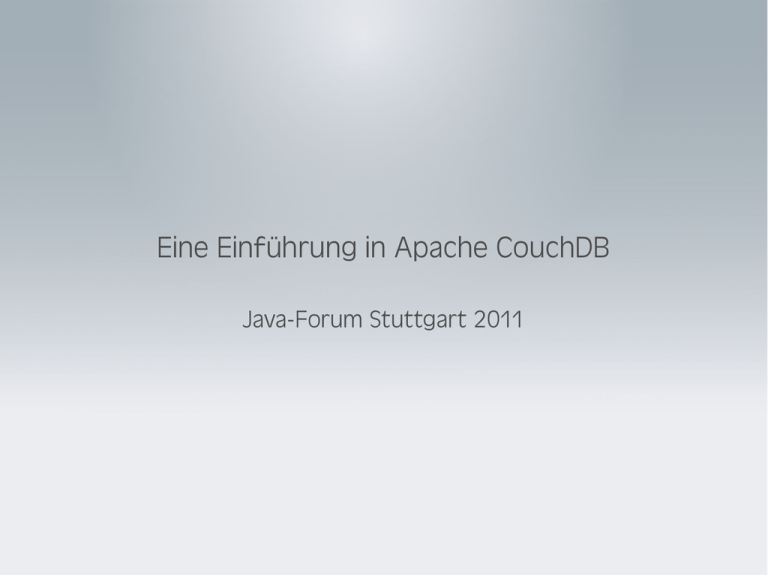
Eine Einführung in Apache CouchDB Java-Forum Stuttgart 2011 Johannes Schneider, cedarsoft GmbH [email protected] http://blog.cedarsoft.com http://cedarsoft.com Vielen Dank CouchDB – The VERY Basics Vorerfahrung? Nebenan spricht ... über ... CouchDB – The VERY Basics Inhalt NoSQL – (ein paar) theoretische Grundlagen CouchDB praktisch Was ist CouchDB? Apache Top-Level-Projekt → Apache 2.0 Lizenz Implementiert in Erlang (uuuh...) Dokumentenorientiert (JSON) Queries per Map/Reduce Inkrementelle Replikation (Master to Master) Bi-Direktionales Konfliktmanagement REST-API Leichtgewichtig Kein Treiber „Internet-fähig“ E6 „RESTful APIs - warum REST mehr als http und XML ist“ Dr. Stefan Schlott ab 15:35 Uhr Erste Eindrücke... Test-DB http://couchdb.cedarsoft.com:5984/_utils → „sandbox“ für Spielereien Multi-Version-Concurrency 1 Client - 1 Database initial put Client w reply _1 v e r ith <Updating file> Update with rev_1 repl _2 v e r h y wi t CouchDB 2 Clients - 1 Database Client A initial put _1 v e r ith w y l rep get with rev_1 <Updating file> put with rev_1 reply w ith rev _2 CouchDB <Updating file> put with rev_1 l i ct f n o -c 409 Client B 2 Clients - 2 Databases initial put Replicate rev_1 rev_1 get with rev_1 Replication rev_2 Konflikt rev_2A rev_2B beide verfügbar rev_2 B Client B Couch B A rev_2 put with rev_1 Couch A Client A put with rev_1 Was ist NoSQL? „Neu entdeckt“ 2009 „Not only SQL“ Wir sind geprägt Datenbank == „Relationale Datenbank“ → gute Erfahrungen → gute Tools → Know-How Wo liegt das Problem? CAP-Theorem Brewer's Theorem Consistency oder Availability opfern, um Partition Tolerance zu erreichen? Bitte entscheiden Sie sich jetzt.... Partition Tolerance Funktioniert, auch wenn das Netzwerk mal hustet... Consistency Jeder sieht zur selben Zeit die selben Daten Änderungen sind atomar Intuition: Absolut unerlässlich Wirklich? Availability Jeder kann immer Lesen und Schreiben Wenn ein Netzwerk beteiligt ist, welches unter Umständen Pakete verlieren kann... ... oder Hardware, die unter Umständen ausfallen kann... ... dann können entweder Consistency oder Availability garantiert werden. → Consistency + Availability nur mit perfekter Netzwer-Infrastruktur und Hardware (Irgendwas geht immer schief) Partition Tolerance P C Consistency A Availability Partition Tolerance P Immer konsistent. Aber Downtime bei Ausfällen CP C Consistency A Availability Postgres MySQL relational Partition Tolerance P BigTable Hbase Tabular MongoDB Terrastore Doc Redis Berkley DB Immer konsistent. Aber Downtime bei Ausfällen CP Key-Value C Consistency A Availability weiterer Tradeoff: Consistency vs Latenz Typisches Problem Zur Hauptzugriffszeit fällt das System aus Partition Tolerance „Immer“ verfügbar. P Aber nicht immer konsistent. CP C Consistency AP A Availability „Immer“ verfügbar. Tabular P Aber nicht immer konsistent. CP C Consistency Cassandra Partition Tolerance CouchDB SimpleDB Dynamo Voldemort AP Doc Key-Value A Availability CouchDB „opfert“ Consistency um immer verfügbar zu sein auch wenn keine Netzverbindung da ist Anwendung muss dafür vorbereitet sein! Replication CouchDB: Alle DBs sind „Master“ Inkrementelles Replizieren put Replication Replication Replication Änderungen werden (eventuell) verzögert propagiert Eventual Consistency → Local Consistency Konflikte können auftreten → Konflikte müssen (manuell) gelöst werden Konflikte praktisch kaum relevant wenn beim Design darauf geachtet wird Updates möglichst vermeiden - statt dessen „ergänzen“ Beispiel: Blog-Kommentare Alle Kommentare in einem Dokument vs Pro Kommentar ein Dokument? Wenn Konflikt-Vermeidung /-Resolving funktioniert, dann Availability maximieren Latenz minimieren „Local Data is King“ Mindestens im LAN Sowieso auf mobilem Gerät (Notebook, Android, IOS) Let's talk about Transactions Gibt es nicht, braucht man nicht Gibt es nicht, braucht man nicht Schreiben eines Dokuments ist (lokal) atomar Faustregel Was bei RDBMs in einer Transaktion passiert, gehört bei CouchDB in ein Dokument Serious Business Open your mind Noch ein kleiner Tipp C3: 11:10 Uhr Das nächste große (Java-)Ding Michael Wiedeking Große Herausforderungen in Java-Land? [email protected] Johannes Schneider, cedarsoft GmbH [email protected] http://blog.cedarsoft.com http://cedarsoft.com Quellen Visual Guide to NoSQL Systems http://blog.nahurst.com/visual-guide-to-nosql-systems CouchDB – The Definitive Guide http://guide.couchdb.org/ Nachtrag Was kommt in eine DB? Was gemeinsam abgefragt wird Security... Wie speichert CouchDB die Daten? Key → Value (JSON-Dokument) UUID / natural ID Key → Value (JSON-Dokument) optional mit Attachments { } "_id": "8629b62422fde9744c80f55c21000b09", "_rev": "1-83611c612f3e113912d5c1b6ef21ea77", "firstName": "Markus", "lastName": "Mustermann" { } "_id": "8629b62422fde9744c80f55c21000b09", "_rev": "2-ed3408bb4c7fa9cf2d2cb32e34f49f04", "firstName": "Markus", "lastName": "Mustermann", "phones": { "mobile": "+49 177 123456789", "work": "+49 7122 123456484", "private": "+49 7032 123456789" }, "createdAt": "2011-07-07" Warum JSON-Dokumente? Views Map/Reduce „in“ der Datenbank Aufbau von B-Trees Key → JSON Value → JSON Query in B-Tree über Key-Range GET .../byName?startkey=“a“&endkey=“z“ JavaScript (oder andere Sprachen mit Hilfe von View Servern) map: function(doc){ emit (doc.firstName, doc); } Resultat Ein B-Tree nach „firstName“ strukturiert { "total_rows" : 2, "rows" : [ { "id" : "8629b62422fde9744c80f55c21000b09", "key" : "Markus", "value" : { "_id" : "8629b62422fde9744c80f55c21000b09", "_rev" : "3-3d7a92f5f459935df5b92bedc906bd7e" "firstName" : "Markus", [...] } }, { "id" : "8629b62422fde9744c80f55c21001a74", "key" : "Martha" [...] } ], "offset" : 0 } Jedes Dokument wird „gemappt“ pro Dokument können 0..n Einträge erstellt werden { } "_id": "8629b62422fde9744c80f55c21000b09", "_rev": "2-ed3408bb4c7fa9cf2d2cb32e34f49f04", "firstName": "Markus", "lastName": "Mustermann", "phones": { "mobile": "+49 177 123456789", "work": "+49 7122 123456484", "private": "+49 7032 123456789" }, "createdAt": "2011-07-07" map: function(doc){ emit (doc.phones.mobile,doc); emit (doc.phones.work,doc); emit (doc.phones.private,doc); } Key und Value sind JSON „Komplexer Key“ map: function(doc){ emit ([doc.lastName, doc.firstName], doc); } kein Schema map: function(doc){ if (doc.lastName && doc.firstName) { emit ([doc.lastName, doc.firstName], doc); } } Best practise [...] "@type": "person", "@version": 1, [..] map: function(doc){ if ( doc['@type'] == "person") { emit ([doc.lastName, doc.firstName], doc); } } Reduce Mehrere Values werden verrechnet → aber bitte auch wirklich „reduzieren“ Summen-Bildung Kontostand Anzahl Einträge Statistik Durchschnitts-Bewertungen Standard-Abweichung Min/Max/... Unique Values Top N Tags Queries Start-Key → End-Key Reverse Grouping (mit Level) Query-Einschränkungen Keys müssen bekannt sein → kein (performantes) Skip → keine absolute Pagination (Linked List Pagination) Queries machen Spaß Aber es geht nicht alles wie gewohnt → Vorher kurz nachdenken Serious Business: Banken Konten-Bewegungen mit „Transaktionen“? Jede Buchung ein Dokument → „aktueller“ Kontostand durch Map/Reduce → Keine Konflikte möglich Cleanup? → DB pro Konto und Monat/Quartal? → initialer Übertrag
